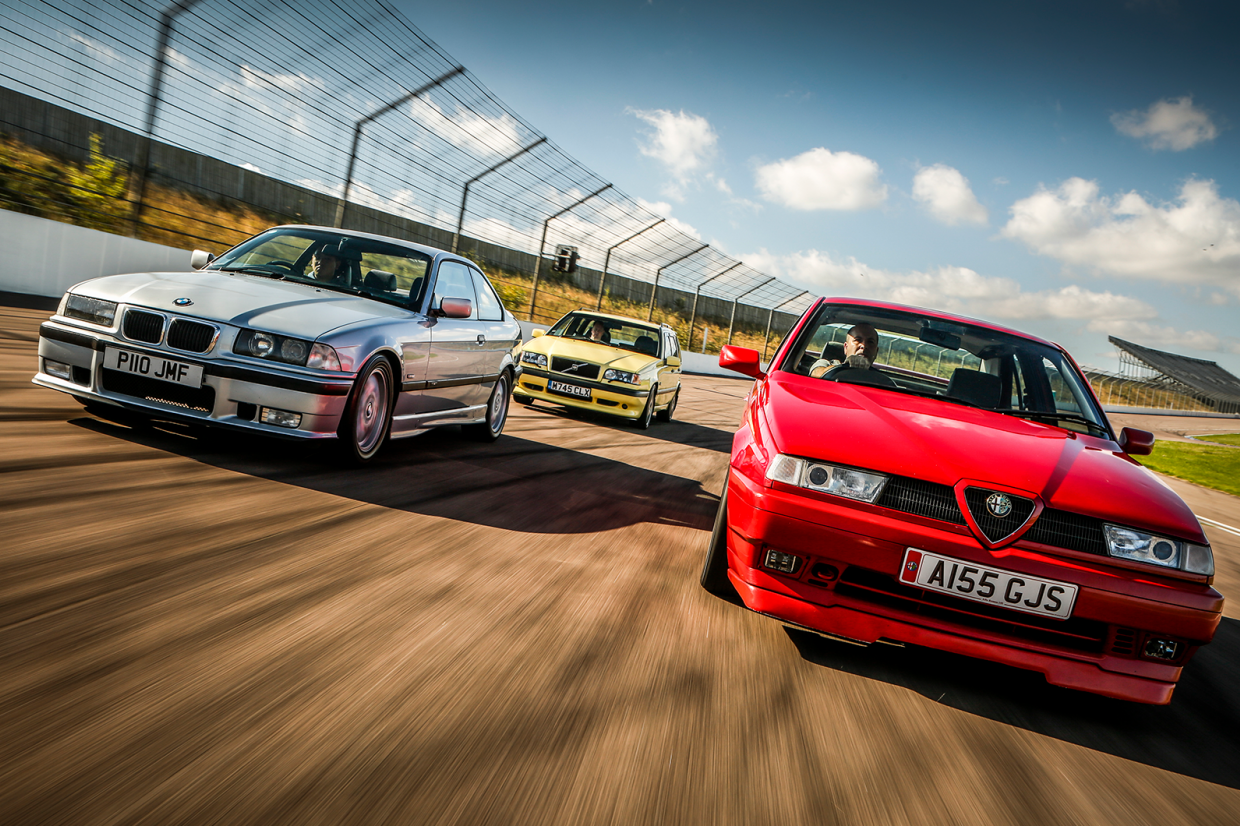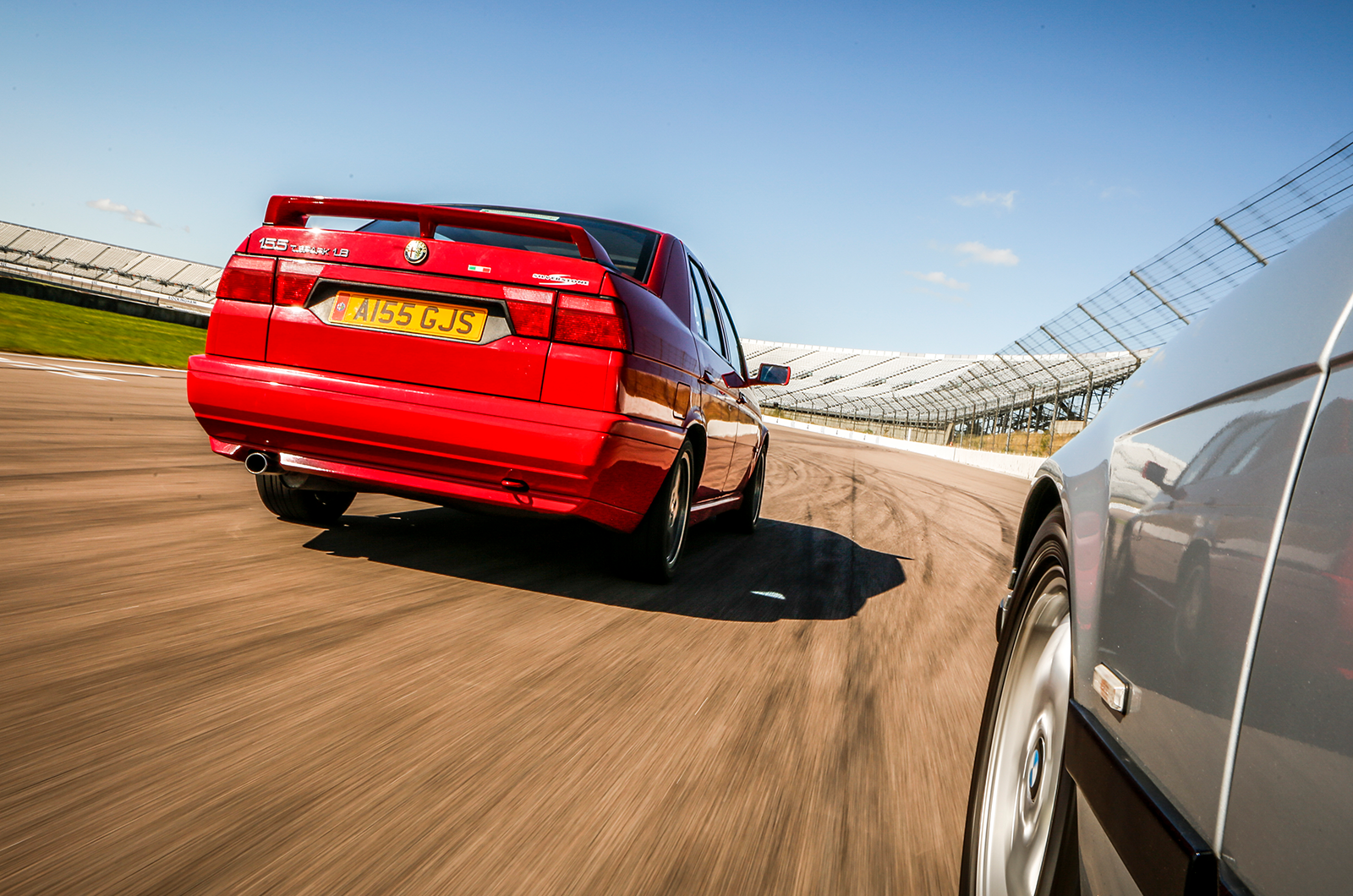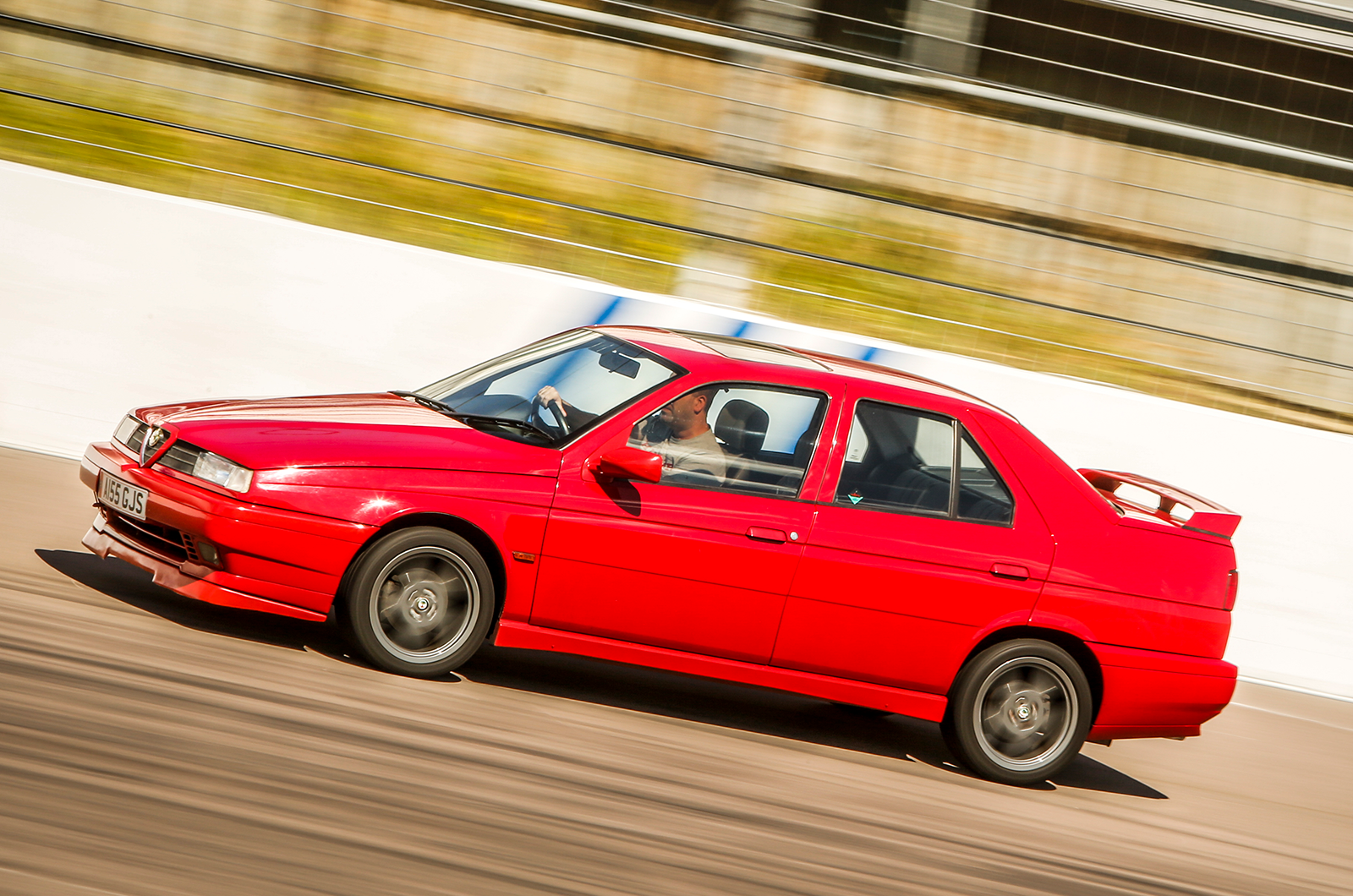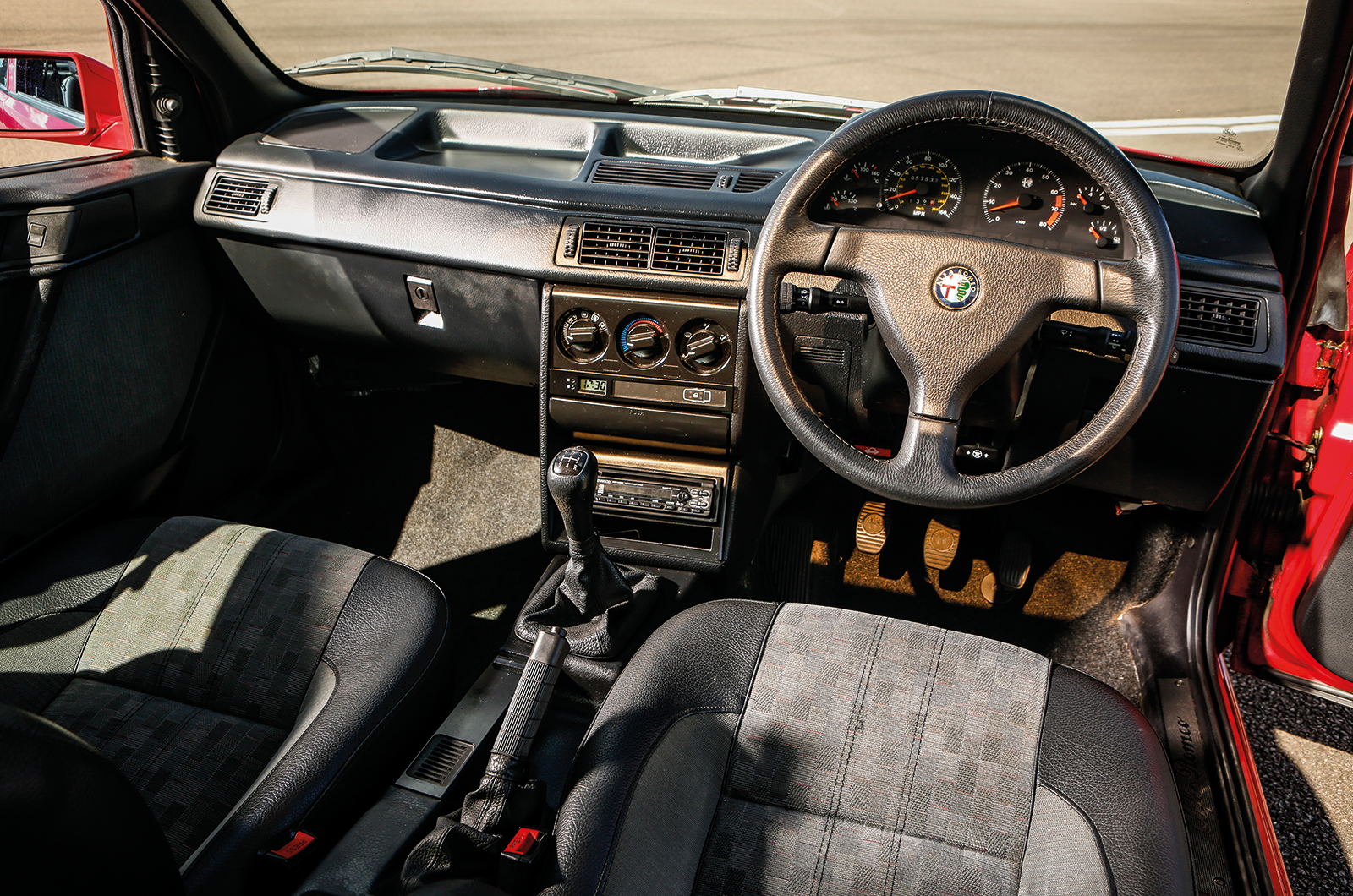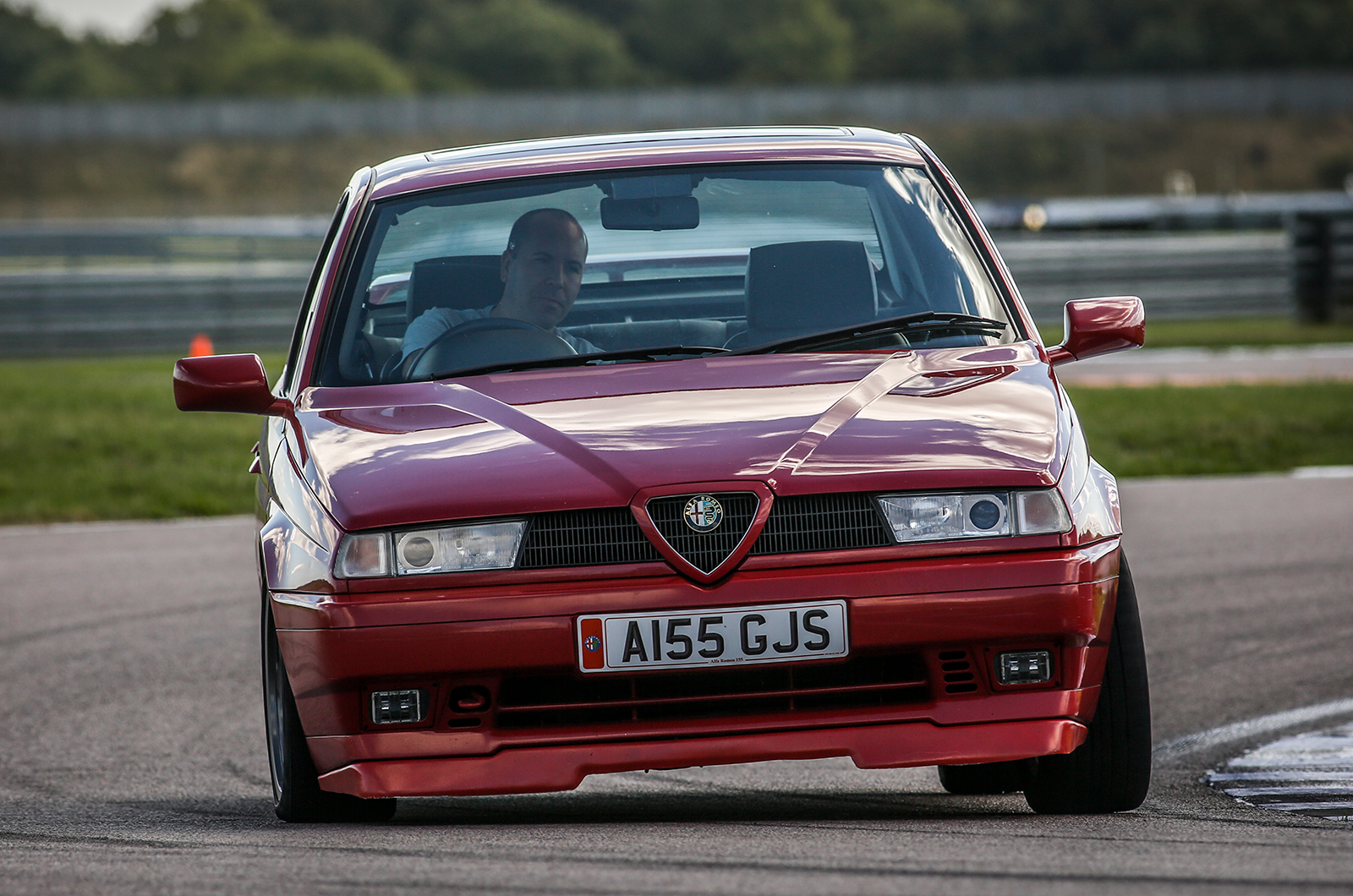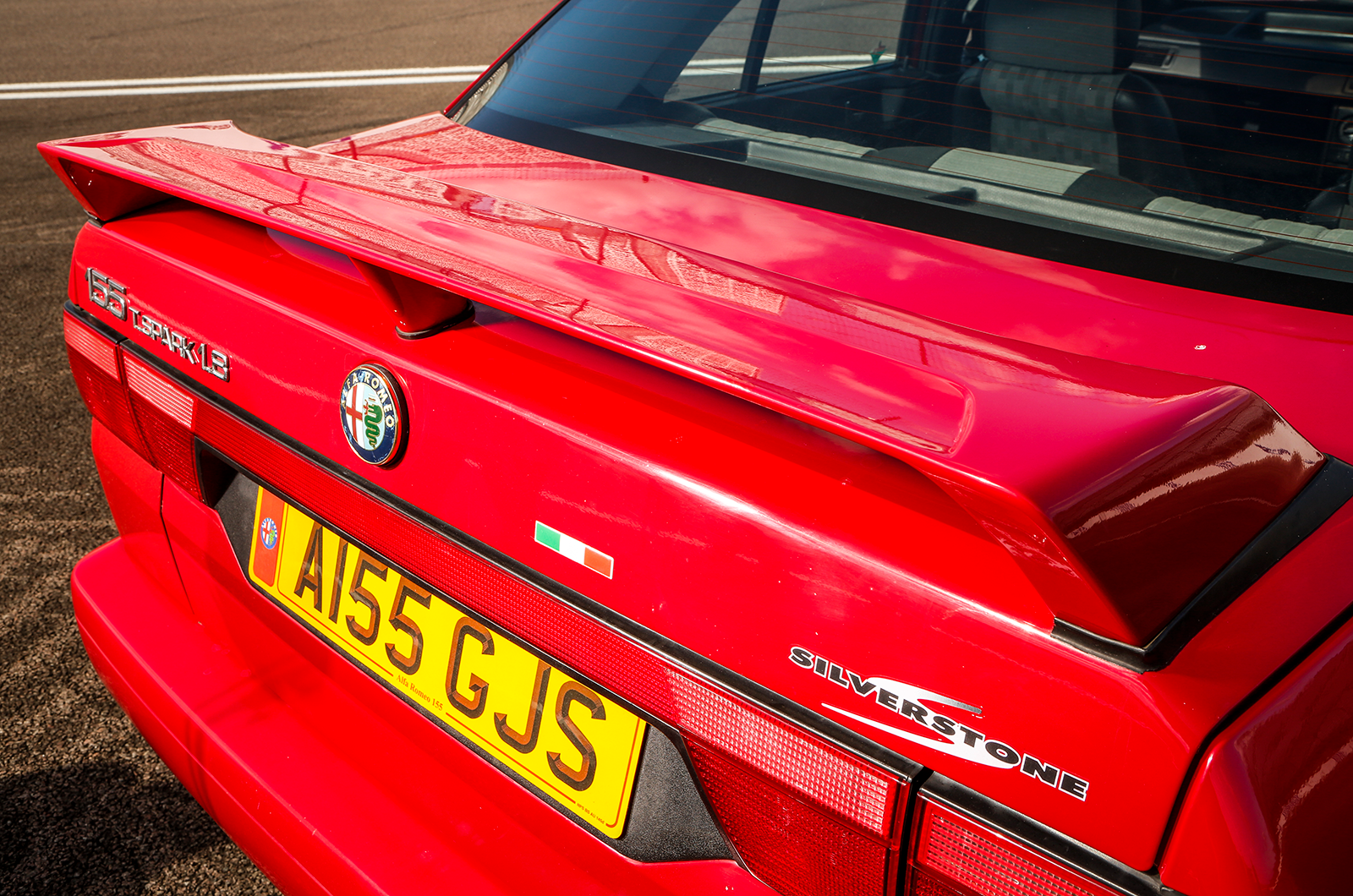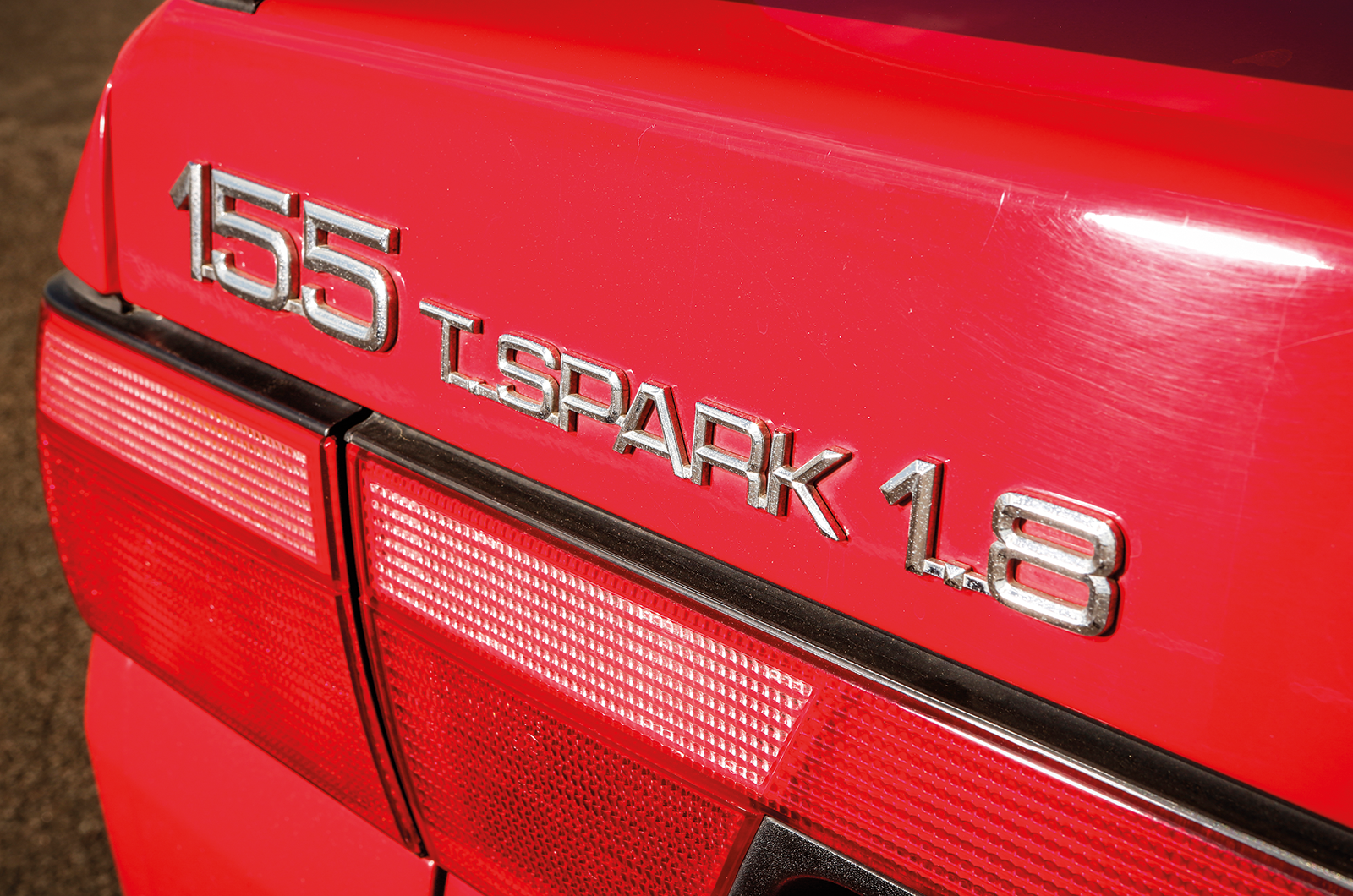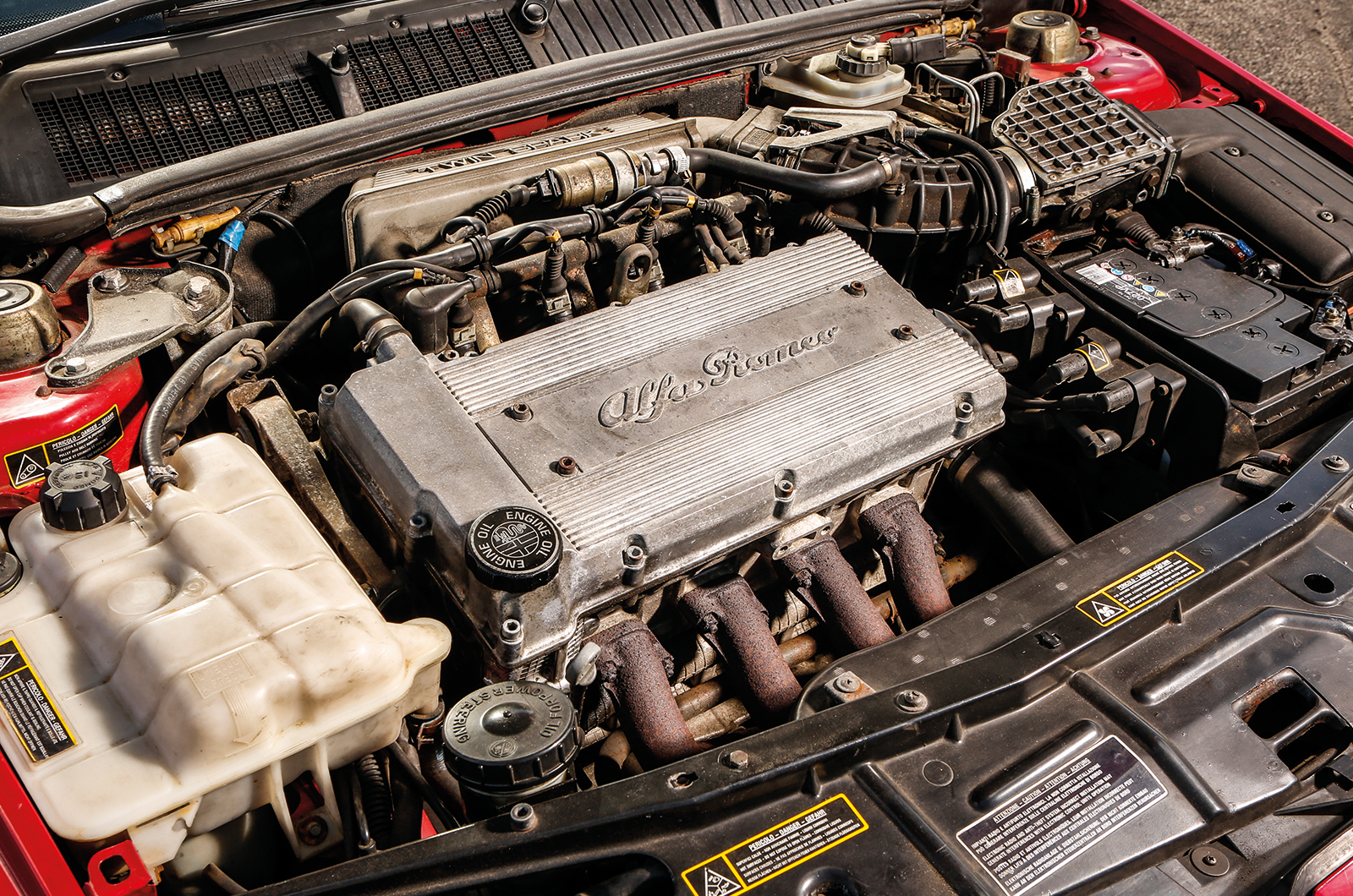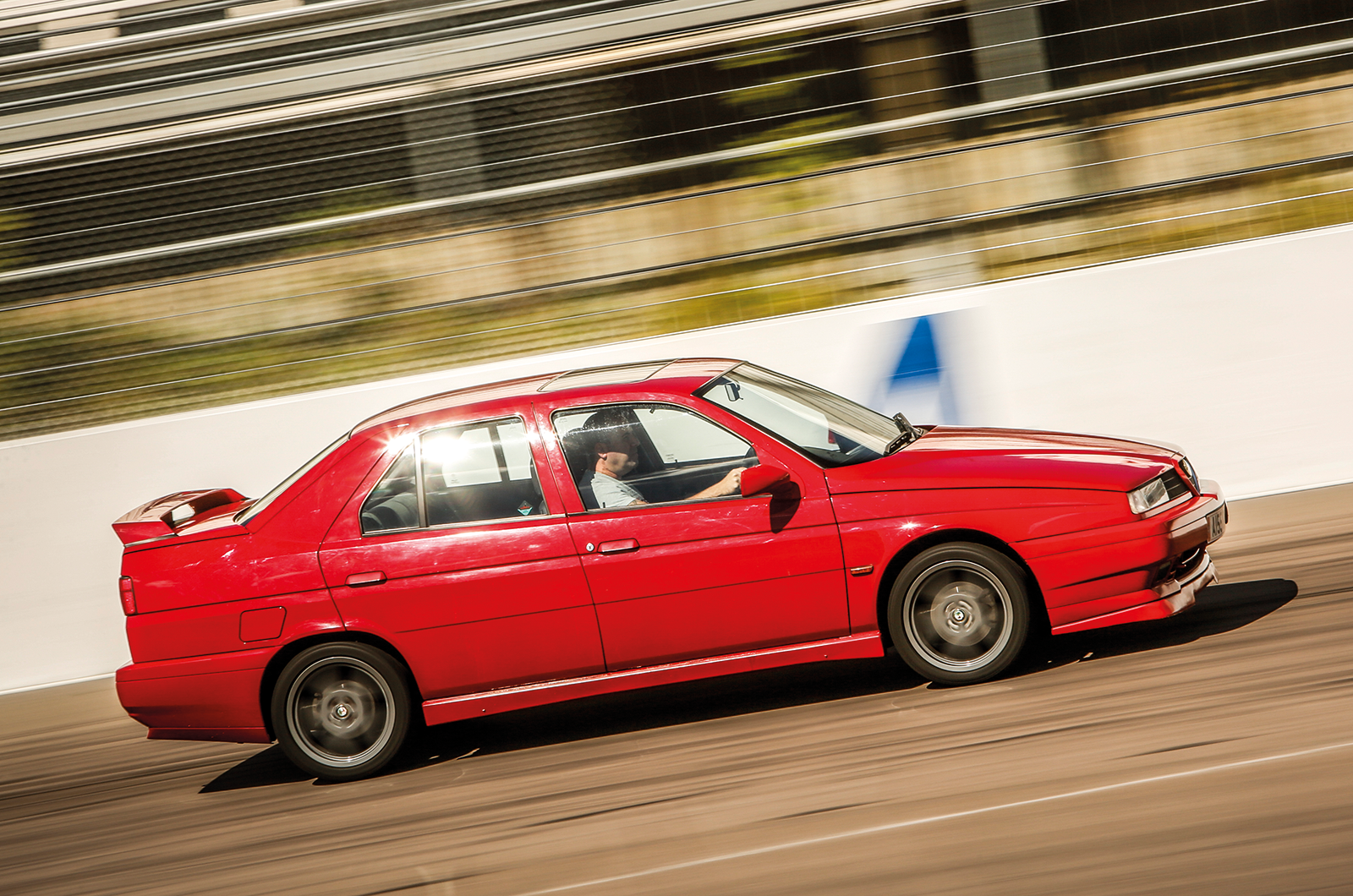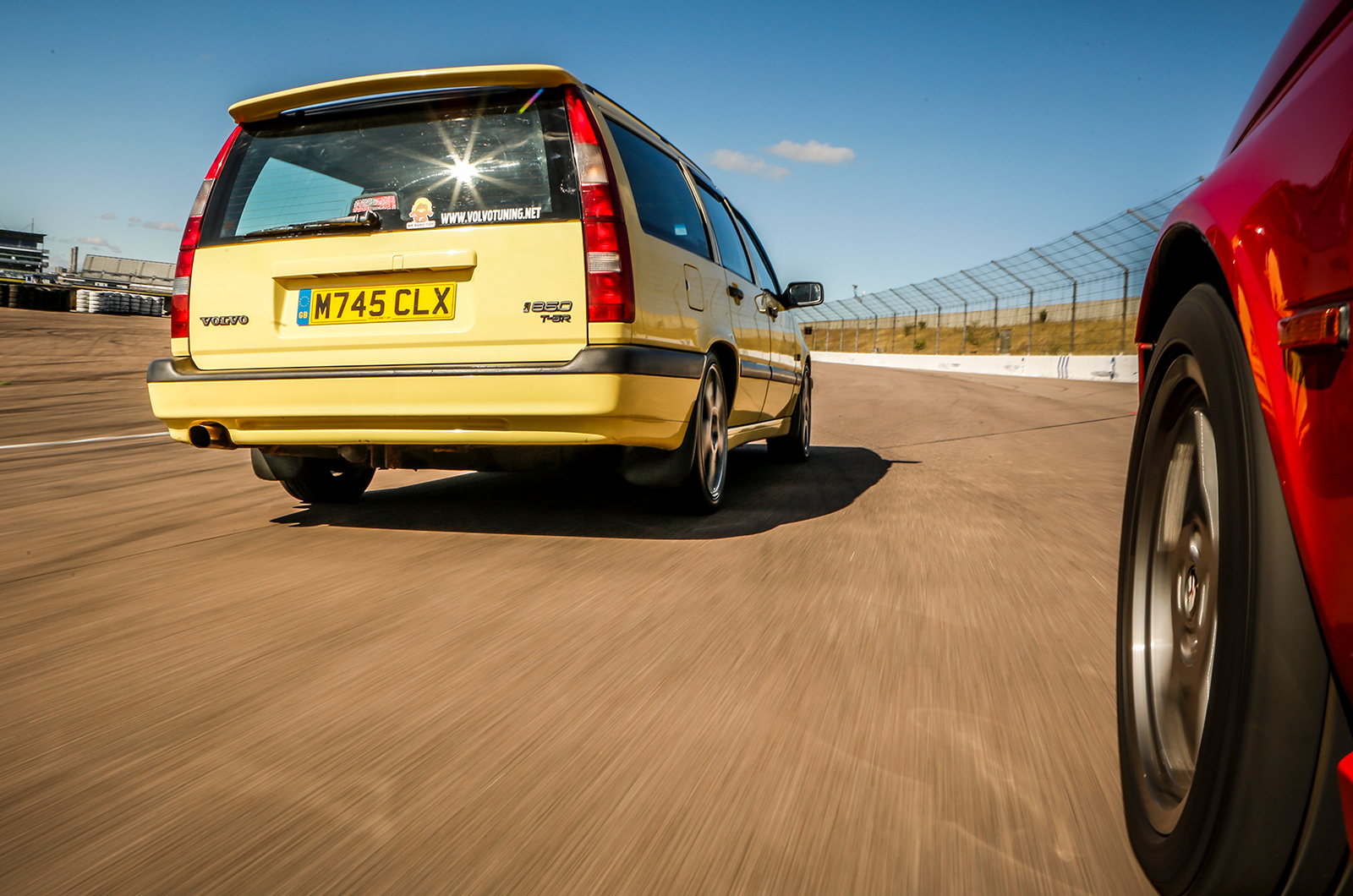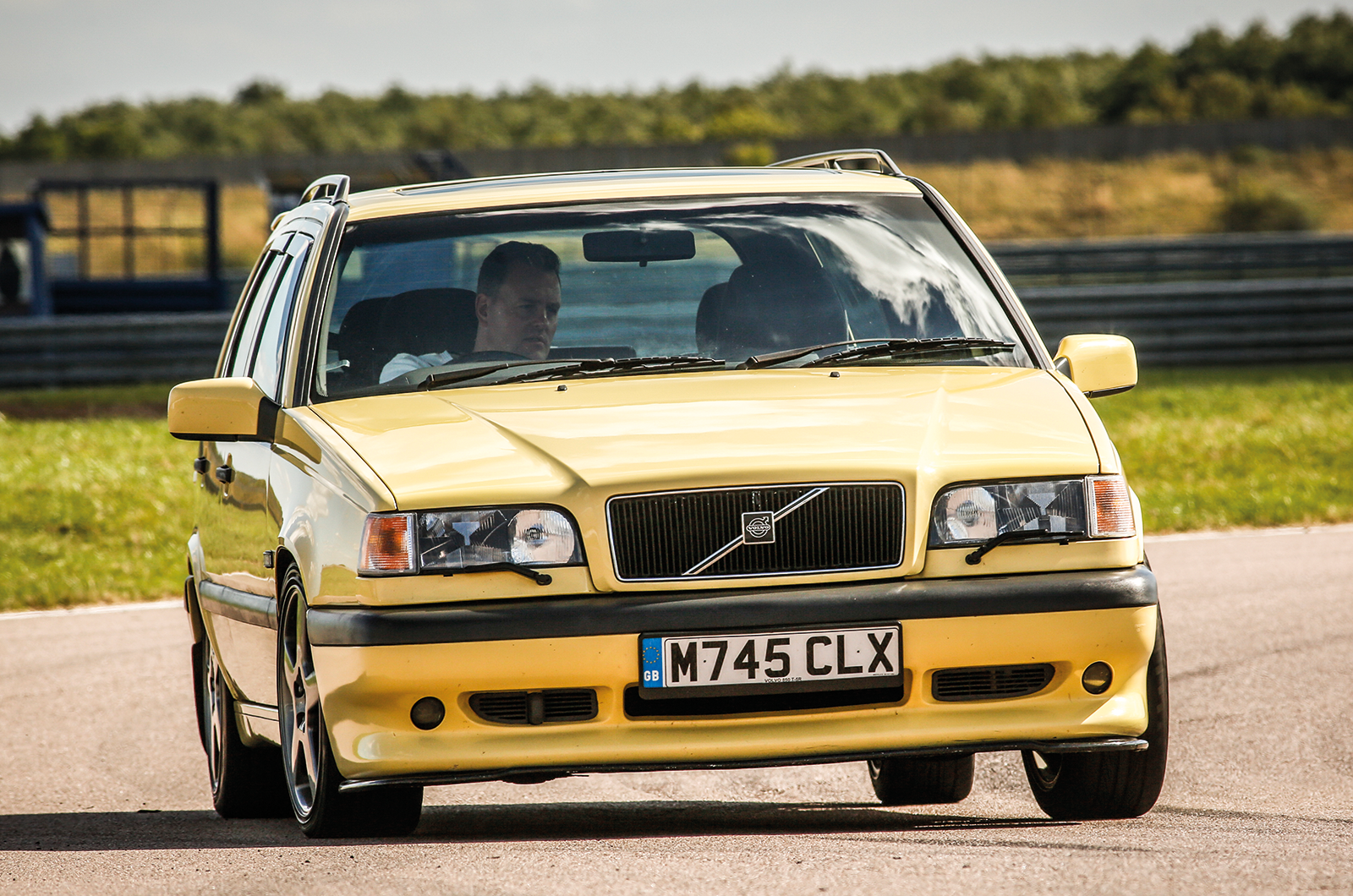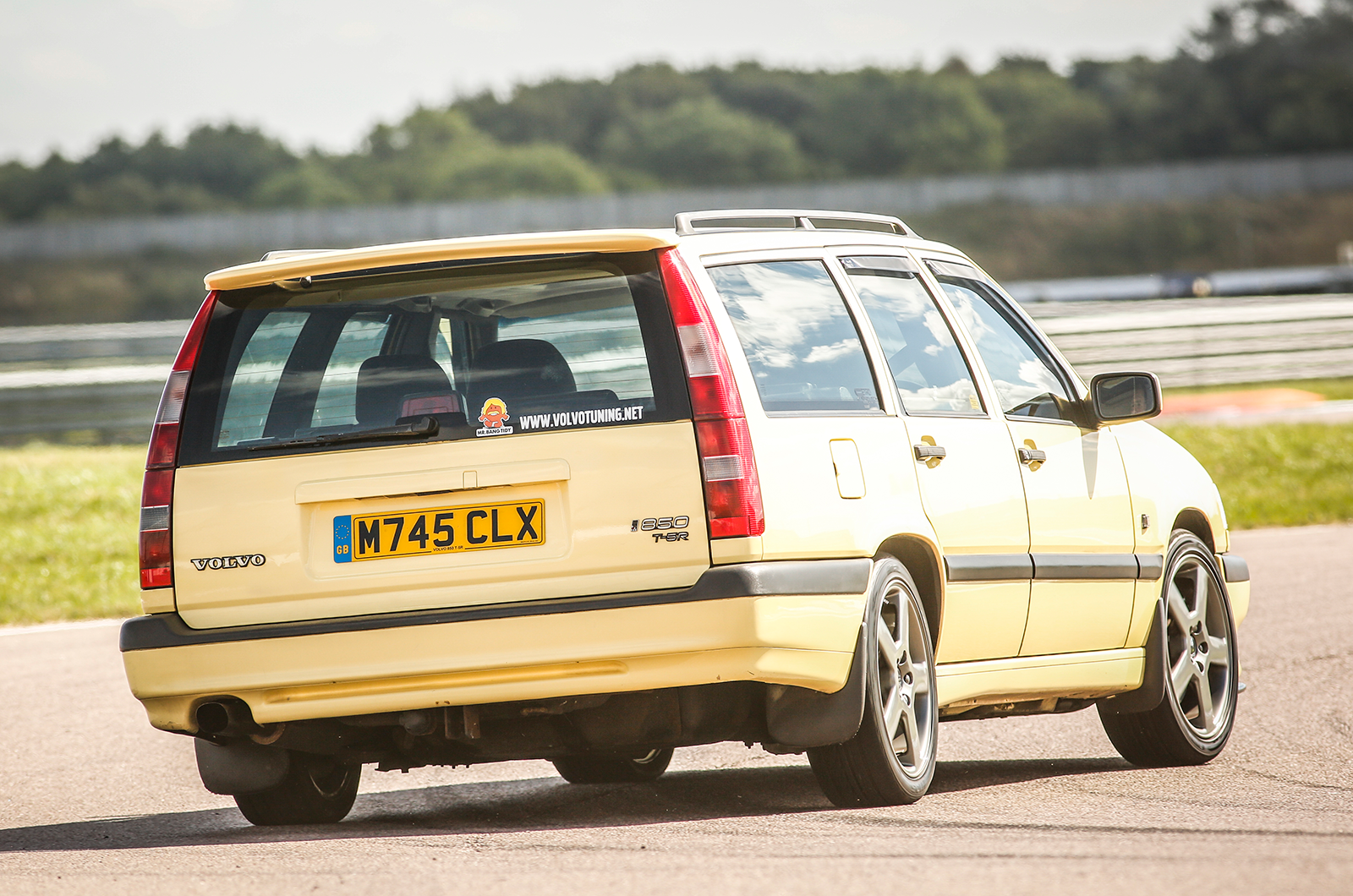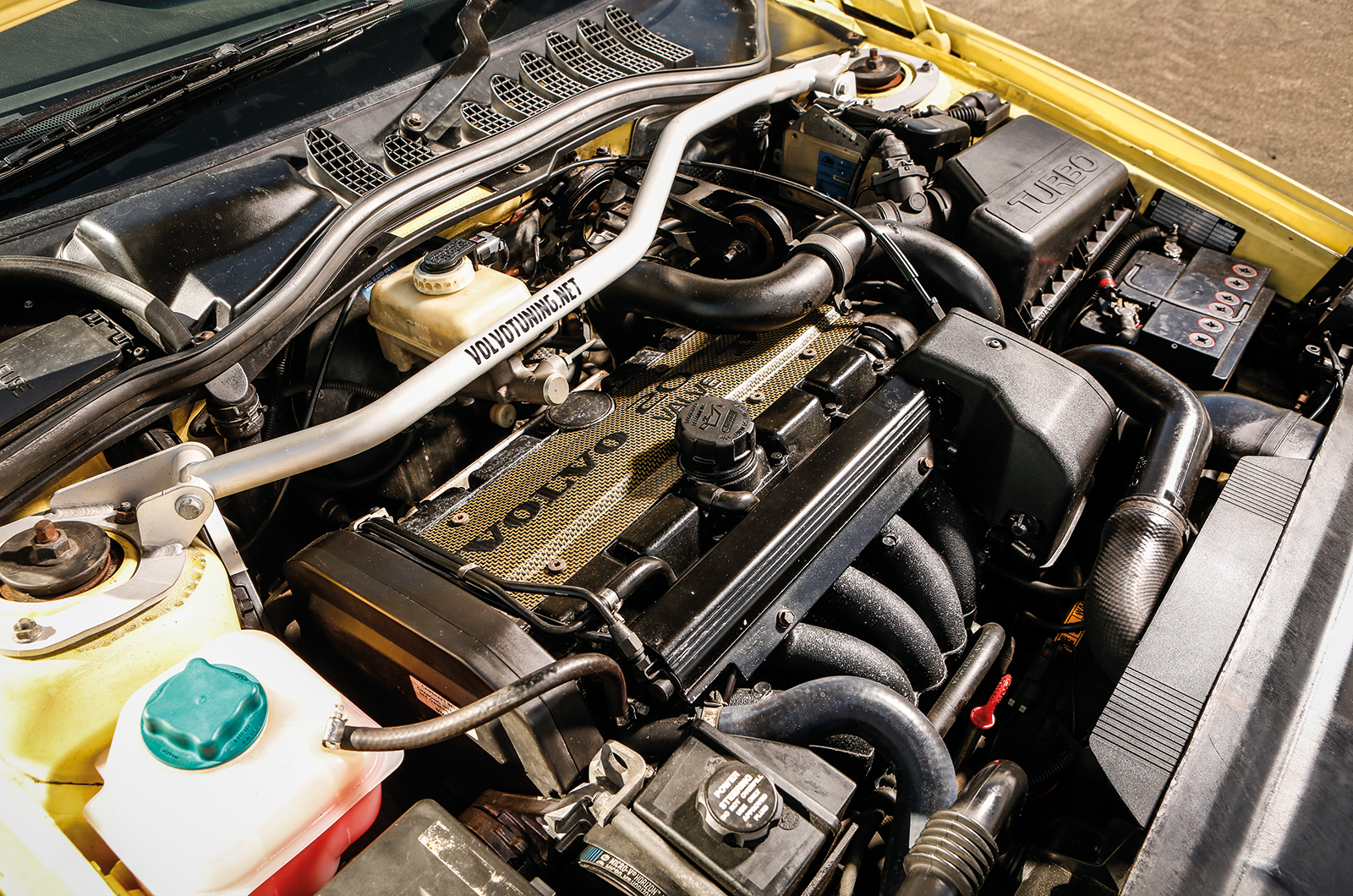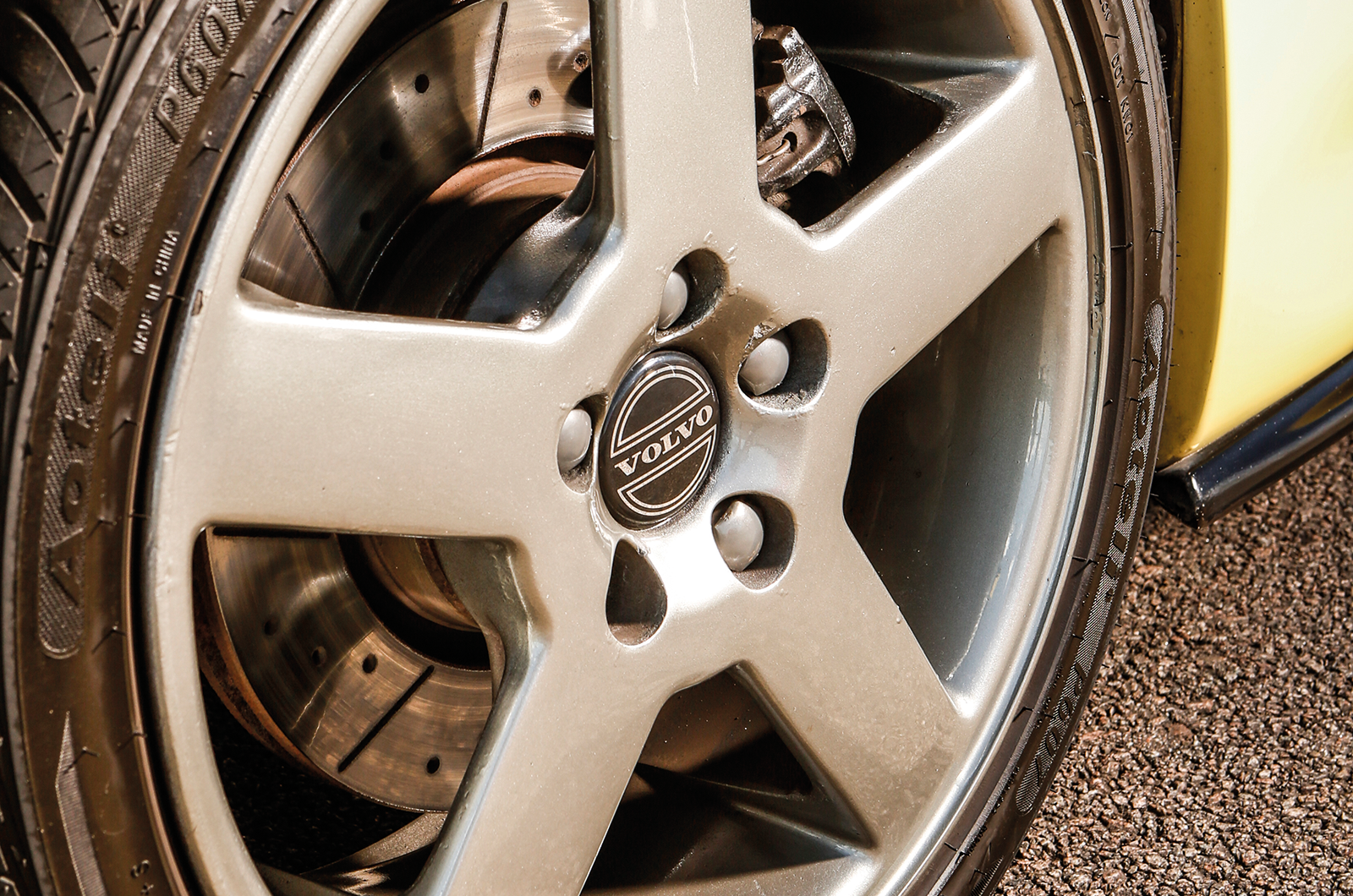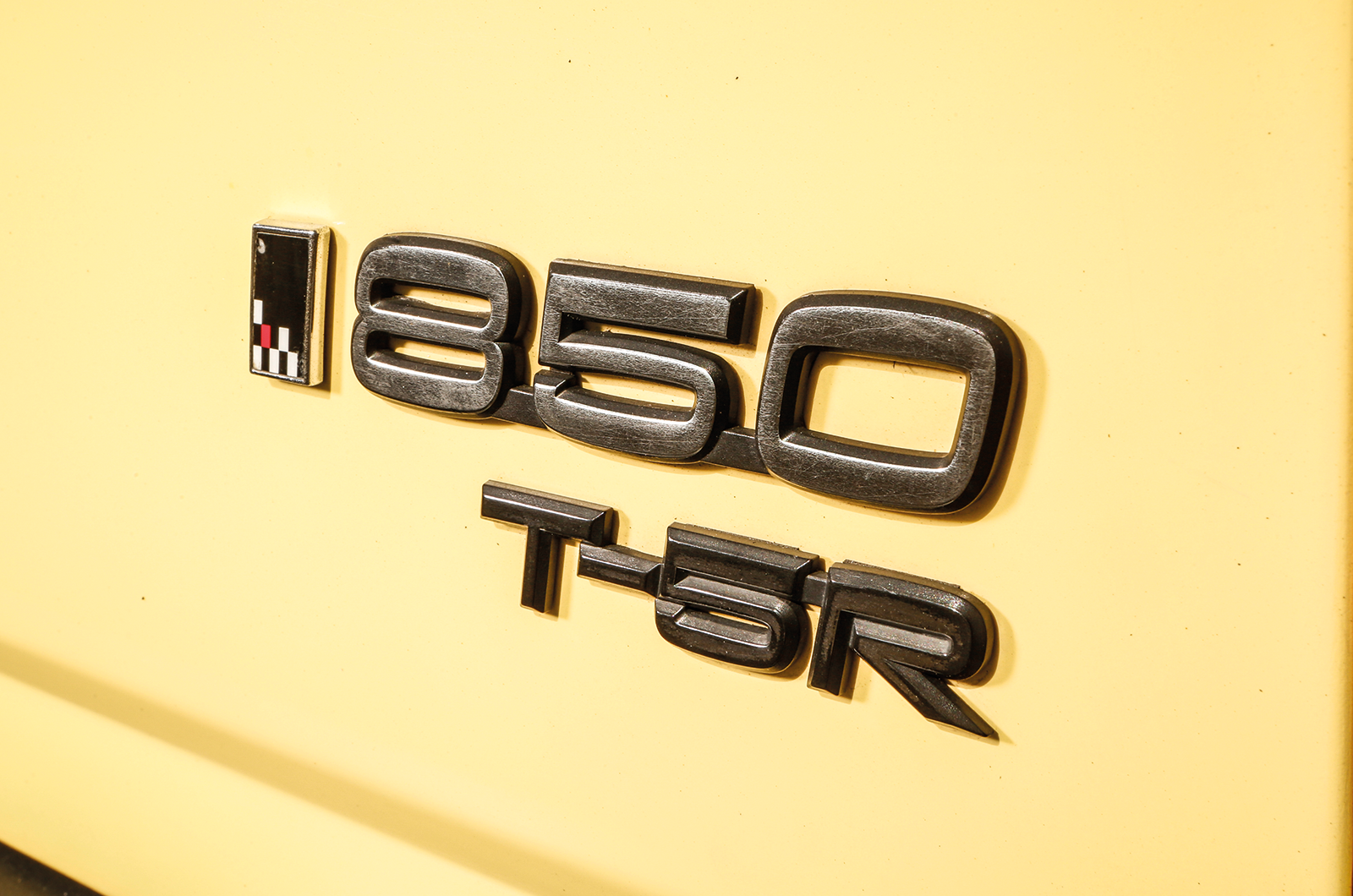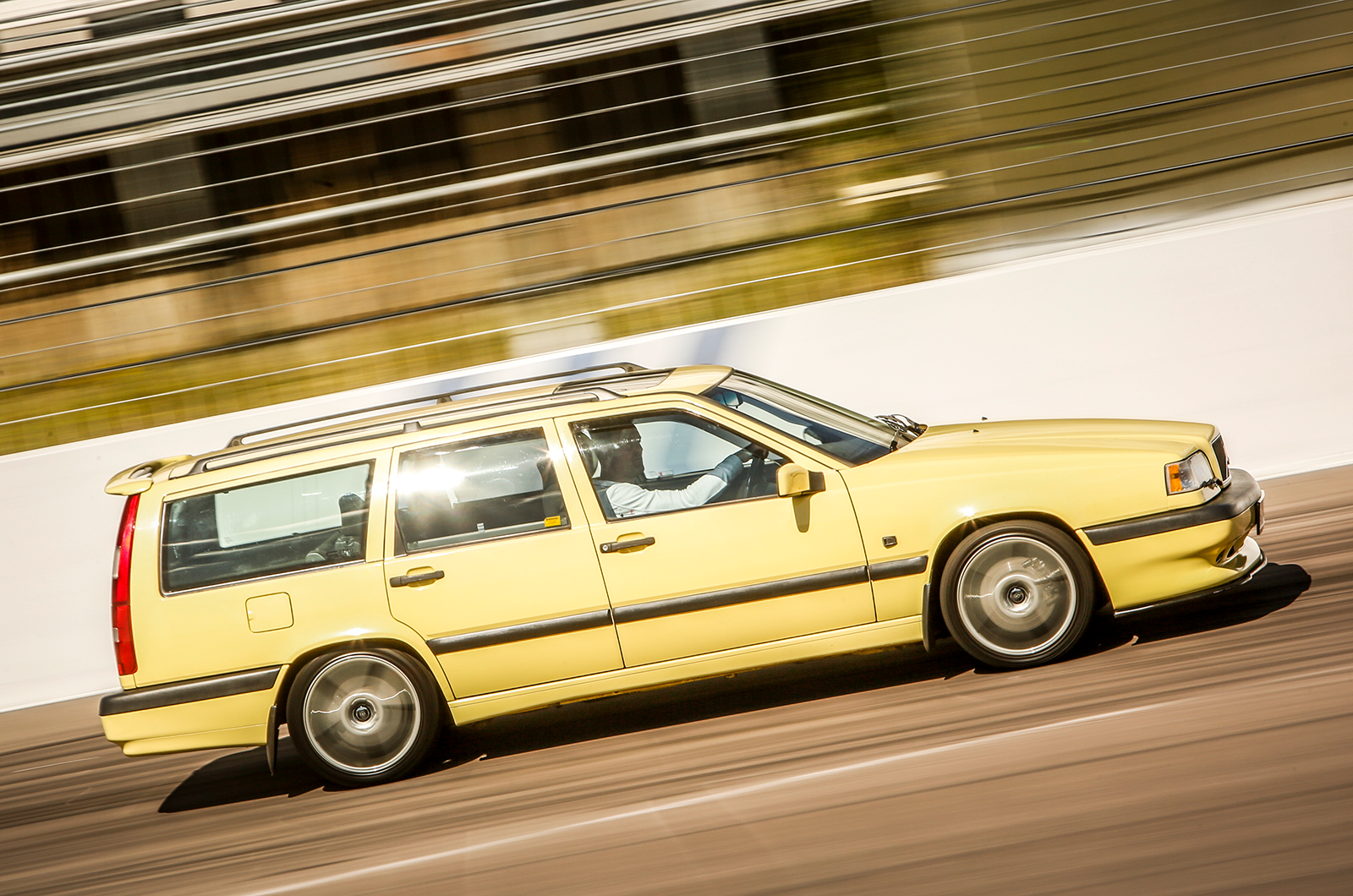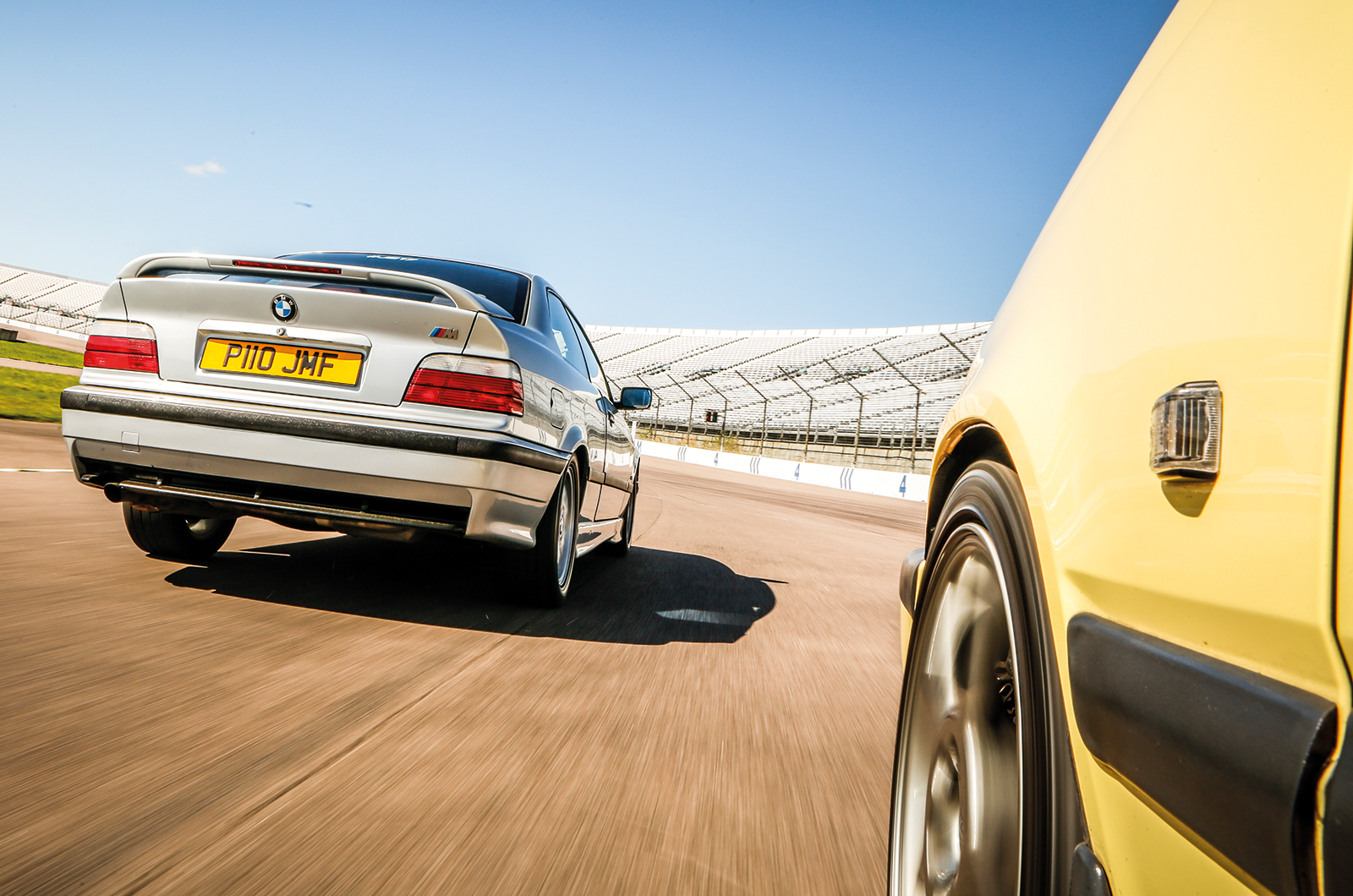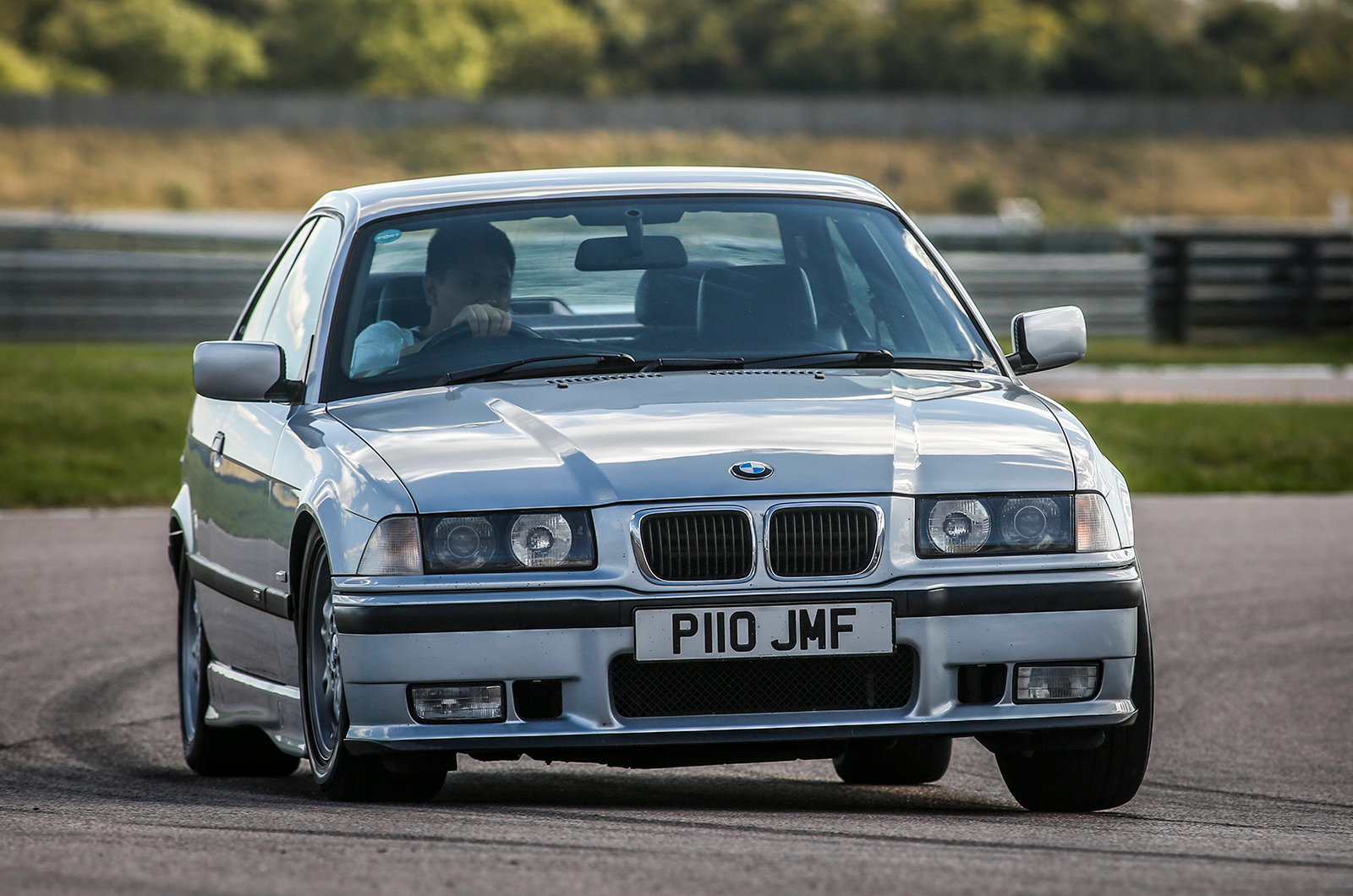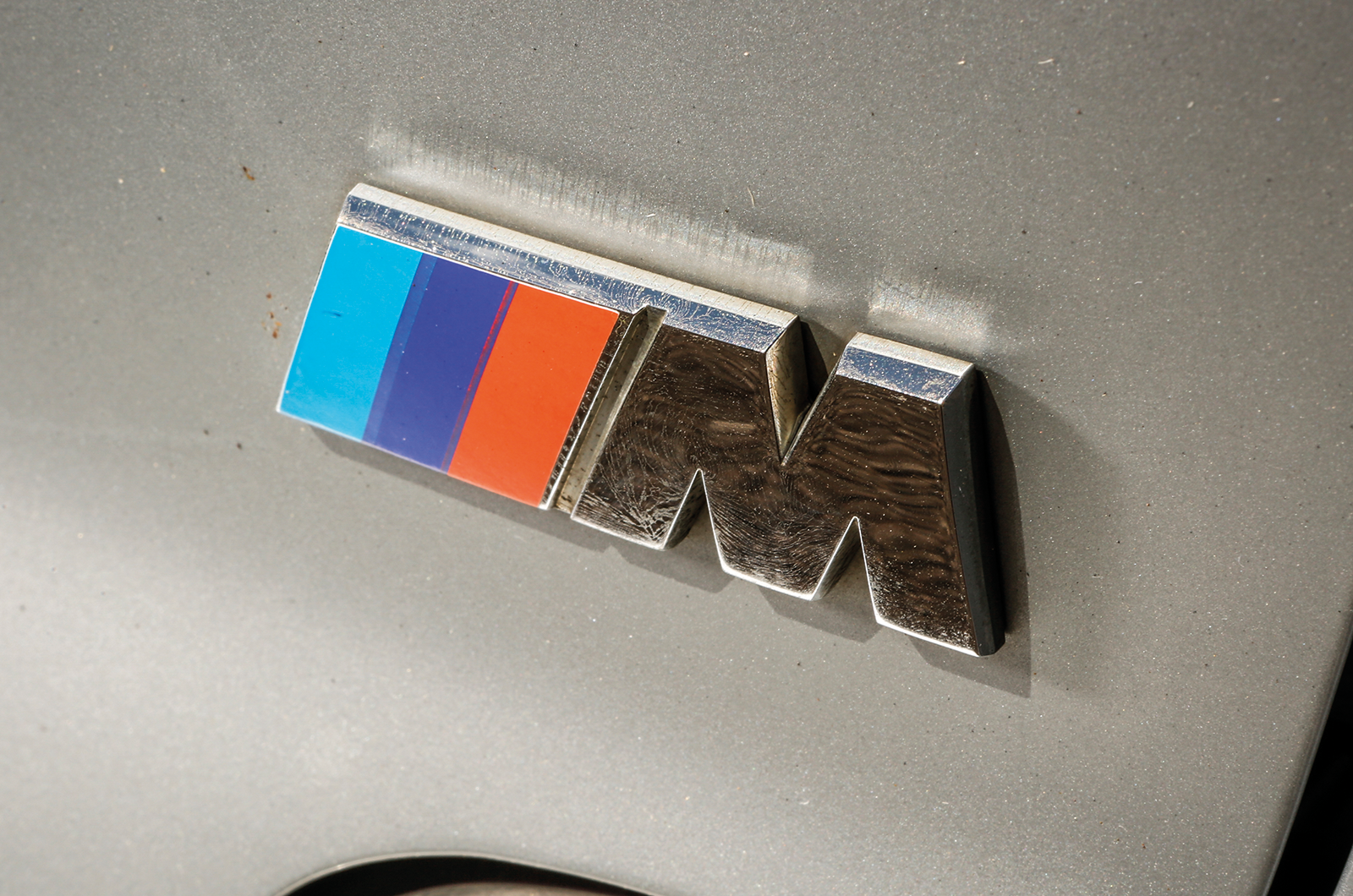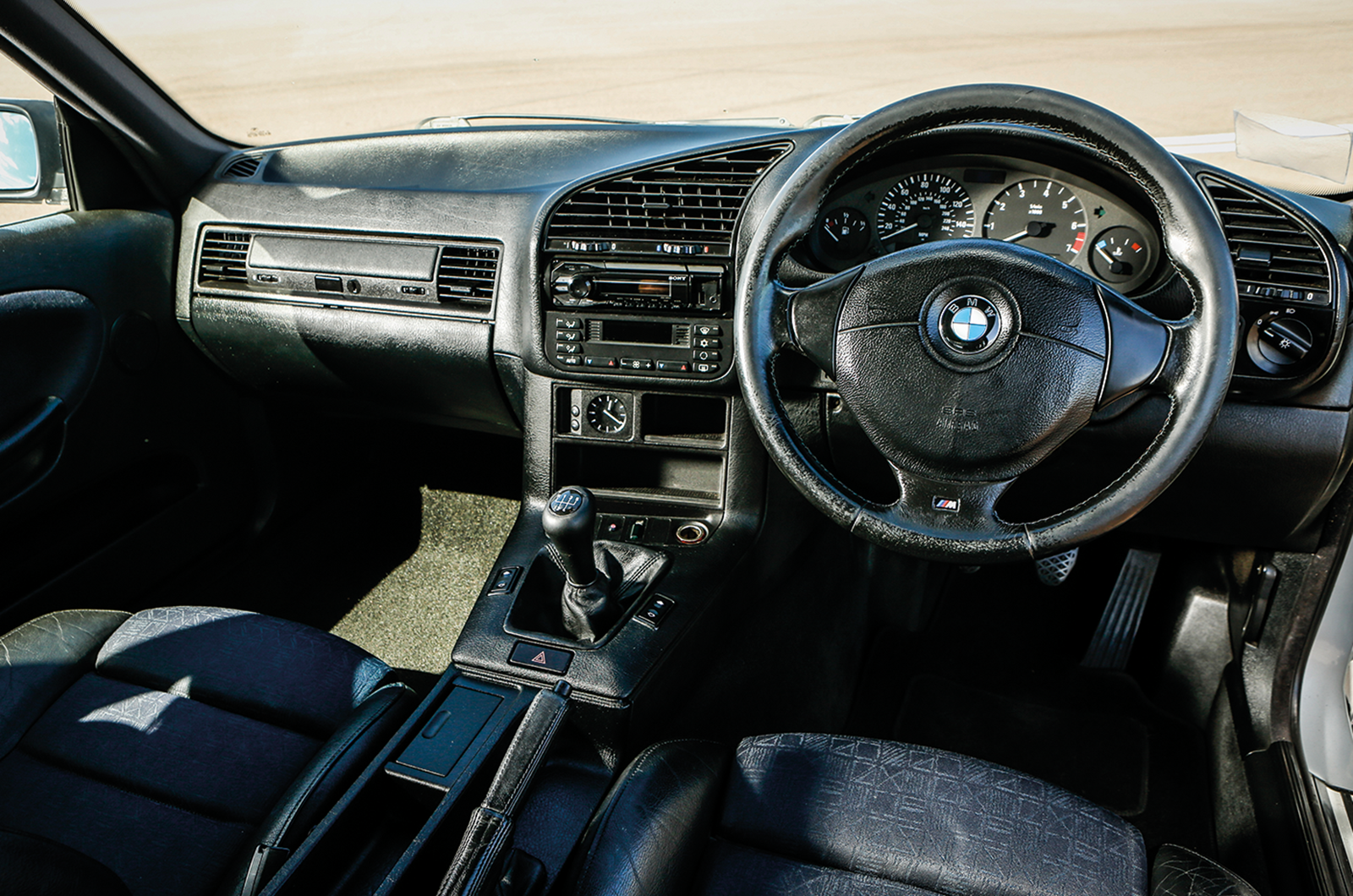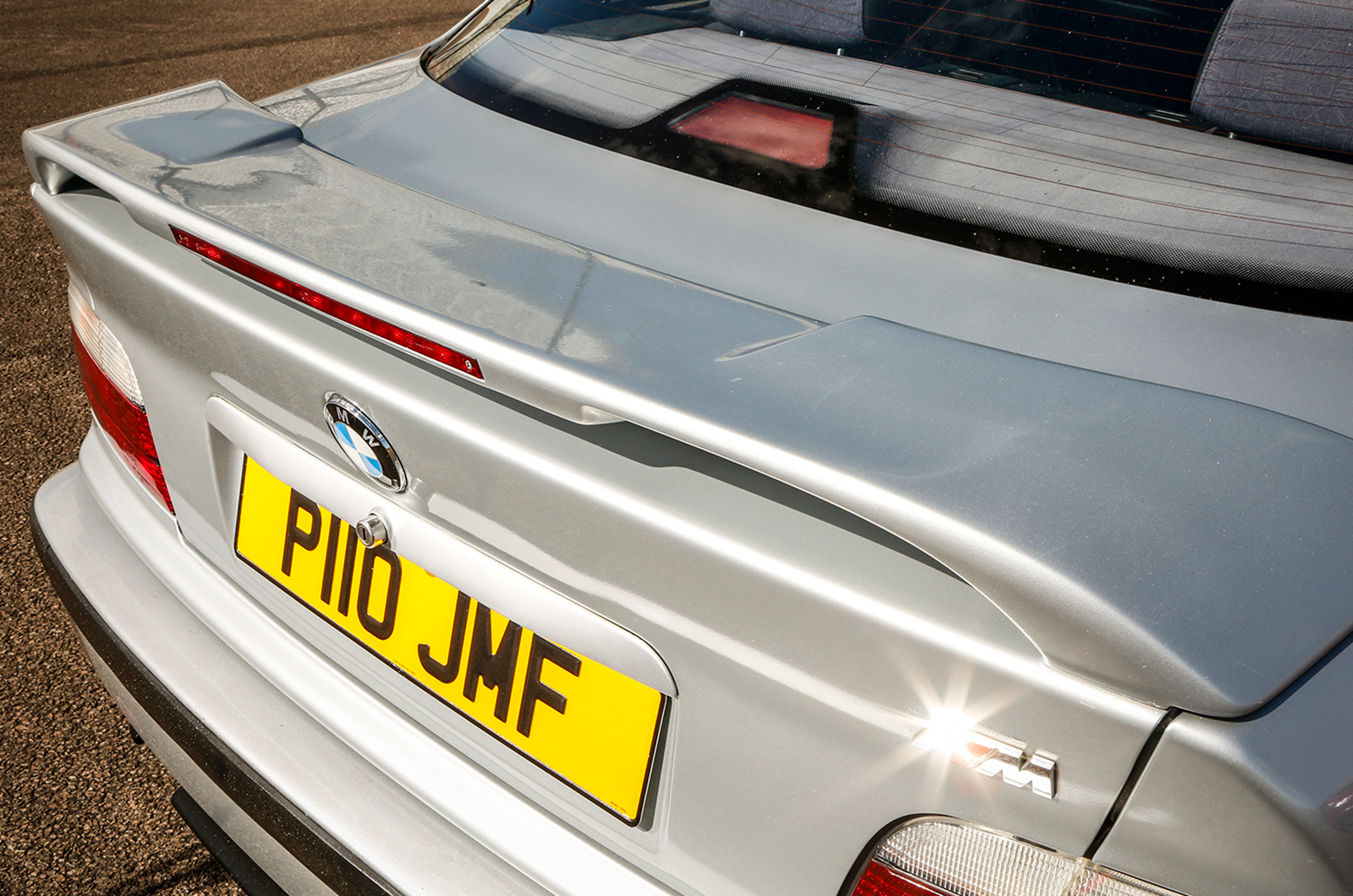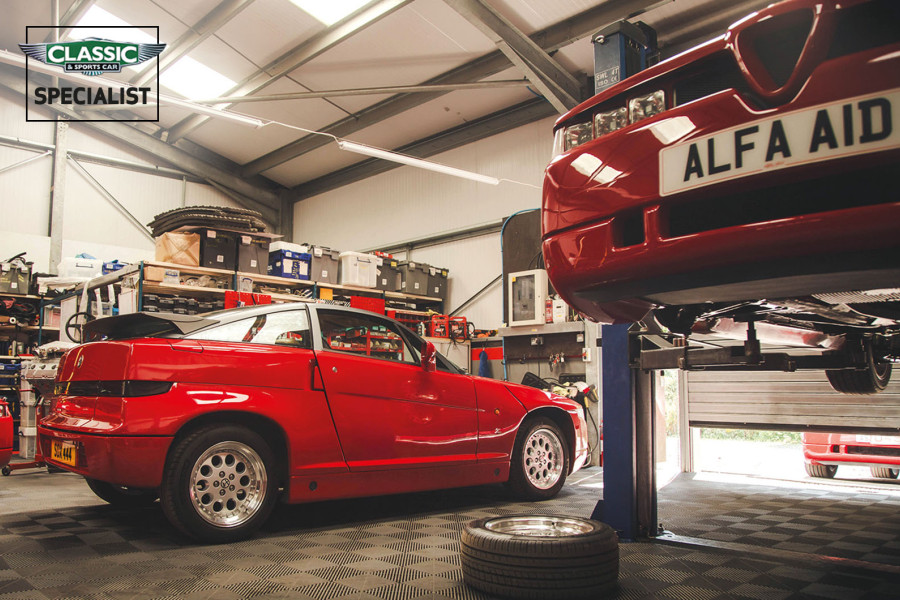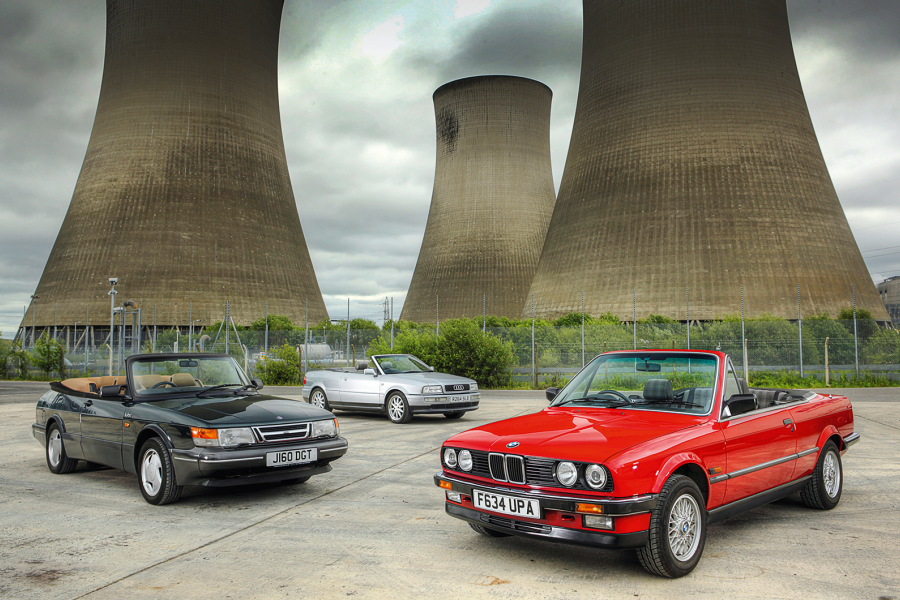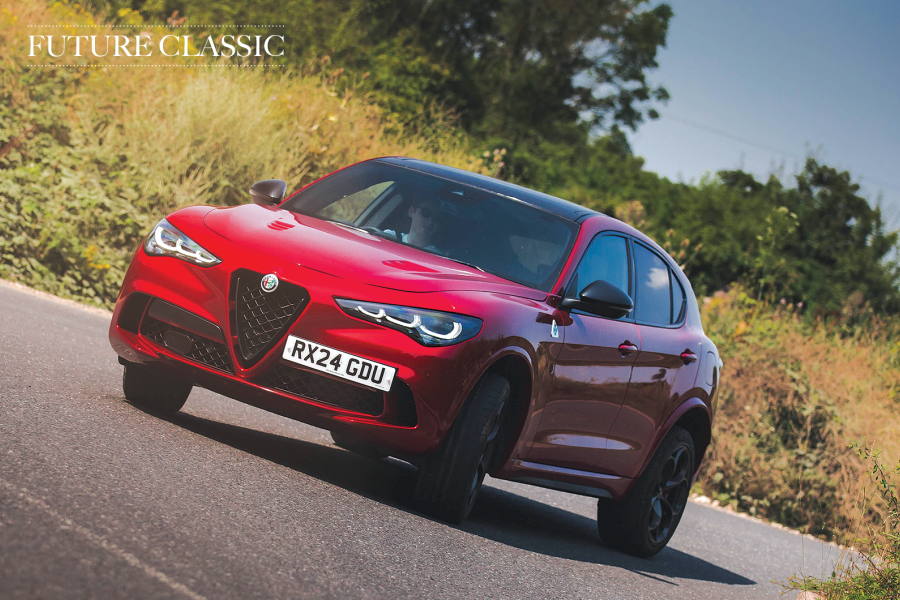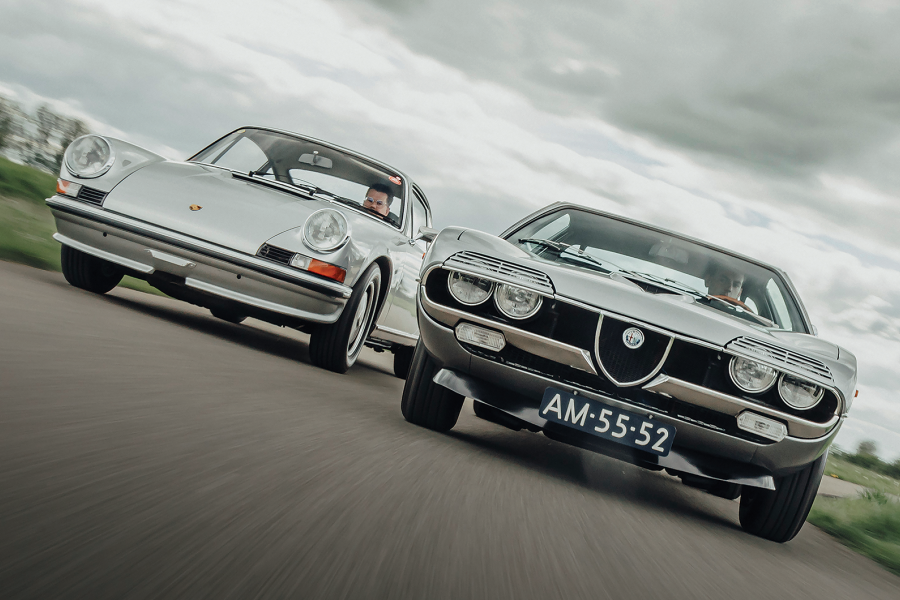The Porsche-designed five-cylinder engine kicks out 240bhp and it’s delivered with a vicious punch to your lower back, plus a soundtrack that’s part gruff exhaust note and part wildly whistling intake.
Drop a cog from fifth to fourth, floor it and the propulsion available is breath-taking.
From 50-70mph, it would demolish most supercars of the era, and with 0-62mph taking just 6.9 secs it leaves our BMW and Alfa on an entirely different motoring plane.
The Volvo’s Porsche-designed engine packs a vicious punch
Through tight bends, the chassis loses a little composure as it struggles to lay down the power, so you have to keep a light foot on the throttle to avoid spinning the wheels; break traction and things get feral, as you battle to rein in its wild power-on nature.
In period, many lamented the bone-jarring lowered and stiffened suspension as being far too brutal for the road, but here on this ultra-smooth surface it produces phenomenal grip for such a big lump.
Forget the leather- and Amaretta-trimmed cabin and its vast capacity, forget the plethora of safety aids – this Volvo is all about baring those considerable performance teeth.
The low-key BMW 318iS (left) was another on-track rival for the erratic Volvo
Over in the German camp, the BMW 318iS formed the basis for its Team Schnitzer-run offering.
For a company on an ‘M’ march, it was a low-key starting point compared to its predecessor, the E30 M3.
Still, it had previous success with the ‘lowly’ 635CSi and in ’93 the 318i had romped to the BTCC title with a one-two finish for Joachim Winkelhock and Steve Soper.
The following year, the team was caught on the hop, as Alfa Romeo snatched the aerodynamic initiative from the original proponents of the be-winged race fiend.
The BMW handles beautifully on its M-Tech suspension
With a weight penalty for rear-wheel drive, the Schnitzer cars spent the first part of the season in the mid-league doldrums, until a change in rules and a weight reduction transformed the BMW and suddenly made it a winner again.
Alfa had a fight on its hands, and from the Silverstone Grand Prix encounter (round 12) onwards the rejuvenated BMWs stormed to victory in five of the remaining 10 fixtures.
When it originally arrived in April 1992, the new E36 instantly consigned to history the E30’s boxy profile. It just looked so modern and fresh.
In truth, it still does. Compared to both Alfa and Volvo it looks a generation newer.
The revered M badge adorns the bootlid of the BMW 318iS
In profile, particularly, it certainly puts the 155 to shame, looking far more resolved.
Owner Charles Thesiera travelled from Newcastle to the south coast to find this Polar Silver iS – sourcing a clean one is tough – and like most Beemers of the period it has an epic mileage, yet it still drives absolutely on the button.
This generation of 3 Series was a real step-change in terms of build quality and styling, and was raced in i saloon and iS coupé forms.
The cabin is discreet but of high quality, with an understated solidity to it, while the steering and brakes are significantly sharper than both of our other cars.
The BMW’s multi-spoke alloys are a change from the Alfa Romeo and Volvo’s five-spoke wheels
This later 1.9-litre iS M44 engine doesn’t sound as soulful as the Alfa’s, but it’s just as eager and shifting through the five-speed manual ’box is a pleasure.
But it’s in the handling department where it excels. The E36 inherited the advanced Z-axle from the Z1 and all coupés came with M-Tech suspension, which included lower, firmer springs and different dampers.
When combined with its rear-wheel-drive layout it means that it can be pushed harder through corners before its outer limits become apparent.
Where the Alfa and Volvo start scrabbling frantically for traction with their respective front wheels, the 318iS simply sticks and powers through.
The E36 BMW 318iS has a well-built, driver-focused cabin
Back on the track in 1994, BMW Schnitzer’s surge came too late.
Despite Alfa Corse’s win ratio tailing off, Tarquini – who survived a spectacular barrel-rolling, door-swinging crash at Knockhill – picked up second-place finishes in rounds 15 and 16, before sealing the championship with another second place in round 18 and a win in round 19, both at Silverstone.
The Volvo 850 estates proved competitive but erratic, eventually finishing 13th and 14th in the championship, yet the sight of them launching over the kerbs, all four wheels off the ground, remains to this day an enduring BTCC image from that breathless season.
And despite the 1995 switch to saloons, it set the groundwork for Rickard Rydell’s 1998 triumph in an S40.
The free-revving ‘four’ in the BMW isn't as tuneful as the Alfa Romeo’s
Of the road cars, the BMW and Alfa offer tantalising glimpses into the worlds of Soper and Tarquini, but even if it never formed the basis for the racer, it’s the T-5R that comes closest to supplying your Touring Car fix.
It reflects the qualities that Alfa’s Giampero Simoni once used to describe the BTCC – “Is frightening. Is fast. Is funny”– but perhaps the greatest attraction of our trio is that you could buy all of them for a fraction of the cost of one Group A-inspired road car.
No wonder the Super Touring era is so fondly remembered.
Images: Tony Baker
Thanks to: Stuart Mills; Volvo Enthusiasts’ Club; Colin and Robert Hughes; Alfa Romeo Owners’ Club; Steve Ball; Stuart Taylor; Kos Loizou
This was originally in our November 2016 magazine; all information was correct at the date of original publication
The E36 BMW 3 Series looked much fresher than the outgoing E30
Meanwhile, in Germany
Over in the Deutsche Tourenwagen Meistershaft, things were a little more hardcore.
Why limit yourself to 2 litres and minimal aerodynamic appendages when there’s so much more automotive pleasure to be had?
In 1993, it adopted the more liberal FIA Class 1 regulations, which allowed a maximum displacement of 2.5 litres and designs of six cylinders.
Pretty much anything else went, with extreme engine, chassis and aerodynamic modifications allowed.
Whilst the Alfa Romeo 155 (left), Volvo 850 (middle) and BMW 318iS fought close battles in the BTCC, the German DTM series was experiencing a golden era, too
Some of the cars were among the most technologically advanced of their time, such as Alfa Romeo’s 155 V6 TI with semi-automatic six-speed ’box, four-wheel drive and 420bhp delivered at a screaming 11,800rpm.
Then there was Opel’s V6 4x4 Calibra, boasting 500bhp and an active suspension system.
Or Mercedes-Benz’s rear-drive 440bhp AMG C-Class, which could have its entire front end – engine, suspension and cooling system – removed and replaced in less than 15 minutes; it would storm to the ’94 DTM title with Klaus Ludwig at the wheel.
Other notable DTM fire-breathers to compete that year included non-factory BMW E36 M3s and Ford Mustangs.
Factfiles
Alfa Romeo 155 TS Silverstone
- Sold/number built 1994-’95/2500
- Construction steel monocoque
- Engine all-alloy, dohc 1773cc inline ‘four’, Bosch Motronic multi-point fuel injection
- Max power 129bhp @ 6100rpm
- Max torque 122lb ft @ 4800rpm
- Transmission five-speed manual, FWD
- Suspension independent, at front by MacPherson struts rear trailing arms; coil springs, telescopic dampers, anti-roll bar f/r
- Steering power-assisted rack and pinion
- Brakes discs (ventilated at front), ABS
- Length 14ft 7in (4443mm)
- Width 5ft 8in (1730mm)
- Height 4ft 8in (1425mm)
- Wheelbase 8ft 4in (2540mm)
- Weight 2646lb (1200kg)
- 0-62mph 10.3 secs
- Top speed 124mph
- Mpg 29.7
- Price new £13,990
Volvo 850 T-5R
- Sold/number built 1995/2500
- Construction steel monocoque
- Engine all-alloy, dohc, turbocharged 2319cc inline ‘five’, multi-point direct-port fuel injection
- Max power 240bhp @ 5600rpm
- Max torque 221lb ft @ 2300rpm
- Transmission five-speed manual, FWD
- Suspension independent, at front by MacPherson struts rear trailing arms, coil springs; anti-roll bar f/r
- Steering power-assisted rack and pinion
- Brakes discs (ventilated at front), ABS
- Length 15ft 6in (4720mm)
- Width 5ft 9in (1760mm)
- Height 4ft 8in (1415mm)
- Wheelbase 8ft 9in (2660mm)
- Weight 3113lb (1412kg)
- 0-62mph 6.9 secs
- Top speed 155mph (electronically limited)
- Mpg 31
- Price new £28,840
BMW 318iS
- Sold/number built 1993-’98/191,053
- Construction steel monocoque
- Engine iron-block, alloy-head, dohc 1895cc inline ‘four’, multi-point Bosch Motronic 5.2 fuel-injection
- Max power 140bhp @ 6000rpm
- Max torque 133lb ft @ 4300rpm
- Transmission five-speed manual, RWD
- Suspension independent, at front by MacPherson struts rear multi-link, double wishbones, coil springs; anti-roll bar f/r
- Steering power-assisted rack and pinion
- Brakes discs (ventilated at front), ABS
- Length 14ft 7in (4433mm)
- Width 5ft 7in (1700mm)
- Height 4ft 7in (1390mm)
- Wheelbase 8ft 10in (2700mm)
- Weight 2778lb (1260kg)
- 0-62mph 9.9 secs
- Top speed 132mph
- Mpg 32.1
- Price new £19,355 (1998)
READ MORE
25 times Volvo surprised the world
BMW M3s: maximum attack
Driving Jochen Rindt’s Alfa Romeo GTA
Ross Alkureishi
Ross Alkureishi is a contributor to Classic & Sports Car
